Open Positions
The nanosatellite laboratory is currently looking for qualified Masters and PhD applicants with an interest in attitude determination and control systems (ADCS), embedded systems development and FPGA programming, and optical payload development.
Specific opportunities will be updated on this page as they become available, however interested candidates are invited to peruse the list of current projects below, and contact Prof. Lee through the "Contact" page.
Current Projects
Micro-photonics for Space Applications Microphotonics is an emerging technology used in many fields ranging from telecommunications, bio-photonics, quantum computing, to various types of sensors. It is a powerful technology that includes the miniaturization of complex optical components and systems to an area on the order of several millimeters. This miniaturization appeals to space applications in particular because it can alleviate various design budgets, while providing comparable if not better performance.
Together with Honeywell and university partners (Carleton, Toronto and Western) we are developing a chip-scale Optical Phased Arrays (OPAs).
The second application which we hope to improve upon is optical communication. With a plethora of satellites being developed and used in constellations, conventional intersatellite and satellite to ground communication infrastructure will be stressed. This has led to significant research into optical communication due to its high bandwidth data communication. A major subsystem in optical communication terminals is the beam steering system, which steers the optical beam to the desired location. The common method is mechanical in nature; however, this is not ideal for space systems due to the numerous moving parts reducing the longevity and reliability of the system. A no moving parts solution is an optical phased array, which uses an array of static phase elements which can be controlled to create a set of induvial waves which constructively interfere, resulting in a wave front propagating in a specific direction. In conjunction with our industry partner Honeywell and various university collaborators we are creating the first 100 emitter optical phased array with a circular aperture on a silicon nitride platform. It should be noted that TEPS has funded a portion of the internship with Honeywell. This design will improve on existing optical phased arrays, in terms of optical losses, range of beam steering and data transfer rates. Improvements in optical communication will enable for higher data transfer between satellites and satellites and the ground allowing for sensors and payloads which produce a lot of data, e.g. space telescope payloads to be more feasible.
Resident Space Objects (RSO) Detection and Tracking Space debris is a rising concern amongst the space community. The amount of debris and objects in orbit around Earth is expected to increase sharply over the next few years and can potentially get out of control as described by the Kessler syndrome. In order to avoid such a catastrophe, all objects in space need to be tracked and monitored. A project initiated in the Nanosatellite research laboratory is focused on tracking these objects using cameras and imaging systems.
Light Curve Analysis for RSO Attitude Determination
Resident Space Object Detection, Identification and Characterization using Artificial Intelligence
Nanosatellite laboratory researchers in collaboration with industry partner, Magellan Aerospace and DRDC are experimenting the implementation of machine learning algorithms for use on star tracker images for orbital estimation of resident space objects (RSOs). The design incorporates the use of Convolutional Neural Networks (CNN) to deconvolute position and motion of RSOs from star tracker images which is to be embedded on a dedicated parallel processing system such as an FPGA. This project is a long-term focus on both machine learning implementation for nanosatellite systems and enhancement of space situational awareness (SSA) using nanosatellite technologies. The project is currently seeking a masters-level student to lead this project with support for current graduate and undergraduate researchers.
Optical Image Simulator
Space Situational Awareness (SSA) refers to all activities to detect, identify and track objects in Earth orbit. SSA is critical to all current and future space activities and protect space assets by providing access control, conjunction warnings, and monitoring status of active satellites. Currently SSA methods and infrastructure are not sufficient to account for the proliferations of space debris. In response to the need for better SSA, there has been many different areas of research looking to improve SSA most of the requiring dedicated ground or space-based infrastructure. One of the largest hurdles to overcome with research in the area has to do with the lack of publicly available labelled data to test and confirm results with. To overcome this, a simulation software, ORBITALS, was created. To verify and validate the ORBITALS simulator it was compared with the Fast Auroral Imager images, which is one of the only publicly available low-resolution space-based images found with auxiliary data. More information on ORBITALS, formerly dubbed SBOIS, can be found in [Clark, 2021].
During the development of the ORBITALS simulator, it was found that the generation of these simulated images is computationally intensive when propagating the entire space catalog. To overcome this, an upgrade of the currently used propagation method, SGP4, was performed to allow the algorithm to run in parallel reducing the computational time required to propagate entire catalogs of RSO’s. From the results it was found that the standard facet model with a particle swarm optimisation performed the best estimating an RSO’s attitude with a 0.66-degree RMSE accuracy across a sequence, and ~1% MAPE accuracy for the optical properties. More details on attitude estimation using the simulator can be found in [Clark, 2021].
Missions
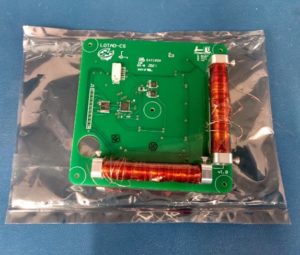
In collaboration with ManitobaSat mission team, we are developing a full suite of ACS hardware for the upcoming CubeSat mission. More information on the mission is available at umstarlab.ca/mbsat
ManitobaSat-1 ACS features custom torque rods and digital sun sensor 3-axis Honeywell magnetometer, gyroscope for rate measurement and micro-processor to host detumble as well attitude determination and fine pointing algorithms. The parts, shown above, have been delivered in 2021, and verification activities are to follow.
The nanosatellite research lab at York University worked on the Resident space object near-atmospheric edge reconnaissance (RSOnar) nanosatellite that was developed as part of the 2019 CSA FAST Program where payloads are launched on a stratospheric balloon provided by CNES. RSOnar consisted of a camera that captured images of RSOs that were post-processed on the ground. RSOnar was launched in Timmins, Ontario in August 2022 to demonstrate the capabilities of a dual purpose star tracker.

RSOnar Payload Integrated Onto Stratospheric Balloon Gondola
As a follow-up to RSOnar, a new CubeSat RSOnar 2 is currently being developed for launch in August 2023 in Timmins. This mission improves upon the success of RSOnar and adds new capabilities. RSOnar 2 has a total of 4 cameras, two of which are supplied by undergraduate students for their course project. For this mission we aim to demonstrate star tracker functions for on-board attitude estimation. Additionally, we demonstrate onboard camera control based on RSO detection.
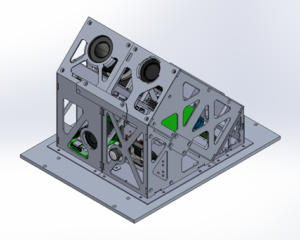
RSOnar 2 Payload Design
Recently Completed Projects
Attitude Determination and Control System (ADCS) The attitude determination and Control System is responsible for estimating and controlling the orientation of a satellite. While there are established set of sensors and actuators, we research potential new components and algorithms that could expand possible missions for small satellites.
Control Moment Gyroscope
Together with a local industry partner we are developing a control moment gyroscope (CMG) for small satellites!
Satellites are constantly under torque perturbation and requires timely attitude correction. Control moment gyroscopes are momentum control devices for attitude control . Control moment gyroscope (CMG) has a high speed flywheel that creates angular momentum which is steered using low powered stepper motor producing resultant torque. We are developing a prototype CMG suitable for small satellites to provide control accuracy as well as the slew capability required for rapid maneuvers in remote sensing missions.
To demonstrate the steering law designed in the team, we are working with the a simple lab model shown below.
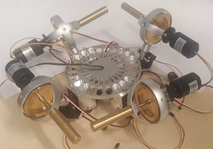
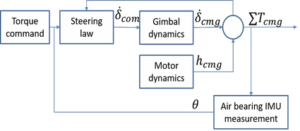
Digital Sun Sensor
Sun Sensor is an essential attitude determination device for small satellites, that is capable of detecting the direction of the sun, which is often represented as a vector or an angle. Nanosatellites have become a popular platform for Earth observation and technology demonstration missions. Being very limited in size, nanosatellites require small components that often have to be low-cost. Thus a demand for small size, high precision Sun Sensor rises. Typical existing designs are composed of photodiodes arranged in a matrix or two orthogonal arrays covered by a structure that allows a beam of light to pass, this is then detected by the photodiodes, and is used to infer the sun vector.
Our very first prototype digital Sun Sensor will be flown on DESCENT CubeSat mission to demonstrate its 0.5 degree accuracy and 120 degree FOV. Next version of the Sun sensor will be flown on IRIS CubeSat as well as the RSOnar mission in 2022.
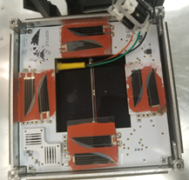
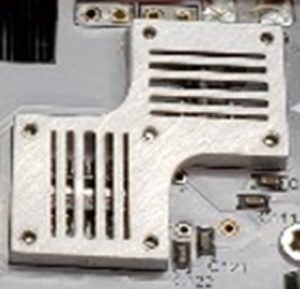
Magnetorquers and Torquer Winder
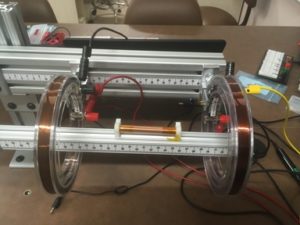
Detumble Study
Detumbling is a stabilization process of a satellite, often following the ejection into space from a launch vehicle. For CubeSat class satellites, detumble process often relies on a magnetometer and a suite of torque rods using magnetic control algorithm. Performance of the detumble is often reported in terms of number of orbits required to reach a reasonable rate of rotation (better than 0.5 deg/sec) from an arbitrary rate (5 to 20 deg/sec) in the satellite’s initial state.
The most common/popular detumble algorithm is based on a well-known method called B-dot control. Sample cases described in the previous section all rely on Bdot control method for detumbling following their initial release from the launch pods.
We are introducing a novel method to detumble namely, Optimal detumble control using Pseudospectral Model Predictive Control (P-MPC). Simulation study is conducted using KASISat and ManitobaSat-1 to compare the performance of BDot and P-MPC.

Nanosatellite laboratory students, in collaboration with Honeywell/COM DEV Ltd, and the National Research Council of Canada (NRCC) are working to develop a thermally stabilized spectrometer for remote-sensing applications based on microphotonic waveguide technology. Nanosatellite laboratory researchers are aiming to demonstrate remote-detection of Methane using a Spatial Heterodyne Spectrometer (SHS) consisting of an array of Mach-Zehnder Interferometers (MZIs) realized via Silicon Nitride strip waveguides on a single microchip.
The microspectrometer instrument consists of 100 pairs of infrared waveguides laid out on a single wafer. Each waveguide is analagous to an optical fibre, hence the instrument consists of 200 individual paths for light to travel through. Each waveguide pair begins as a single waveguide and is then split into two waveguides which are mismatched in length. The path difference between the two waveguides yields a corresponding phase difference in the light; when the waveguides are re-combined an interference pattern is produced. Each waveguide pair or MZI is analagous to a michaelson interferometer set to a fixed position. Using 100 MZI pairs on a single chip produces a set of interferometers each in a different fixed position, just as if a single interferometer were being driven by a stepper motor. Taken all-together this system is a self-contained Fourier Transform Spectrometer (FTS) operating under the SHS principle.

